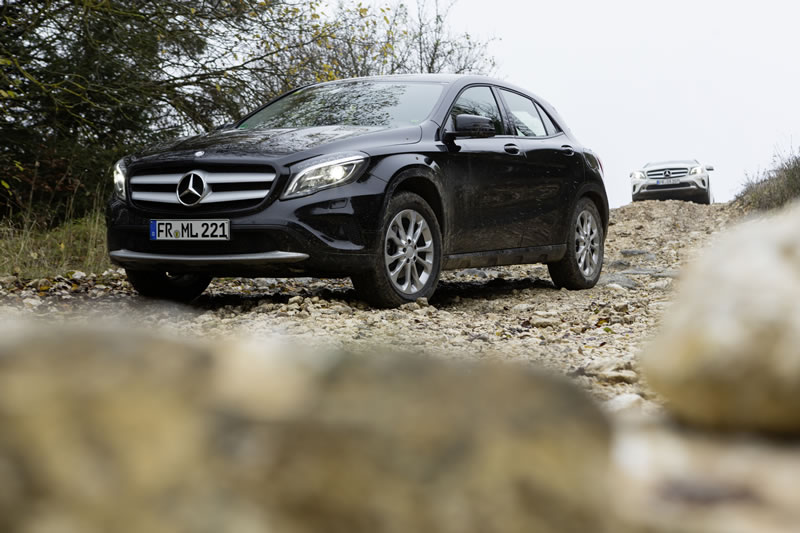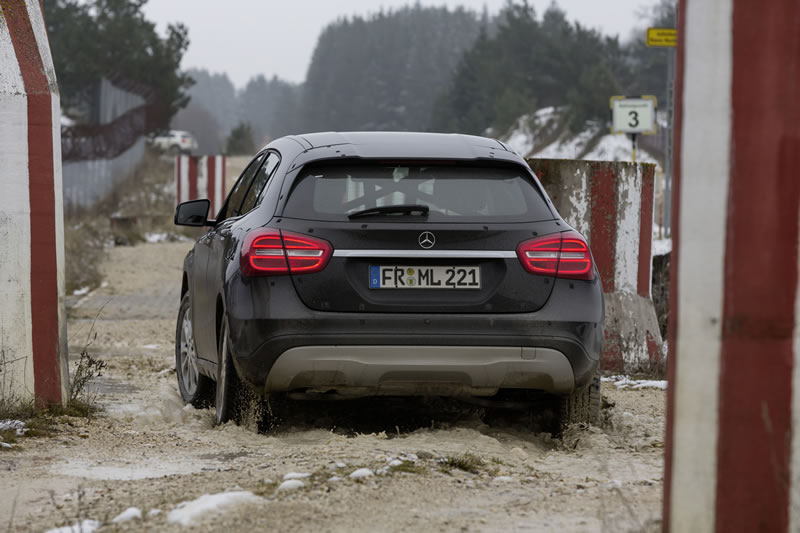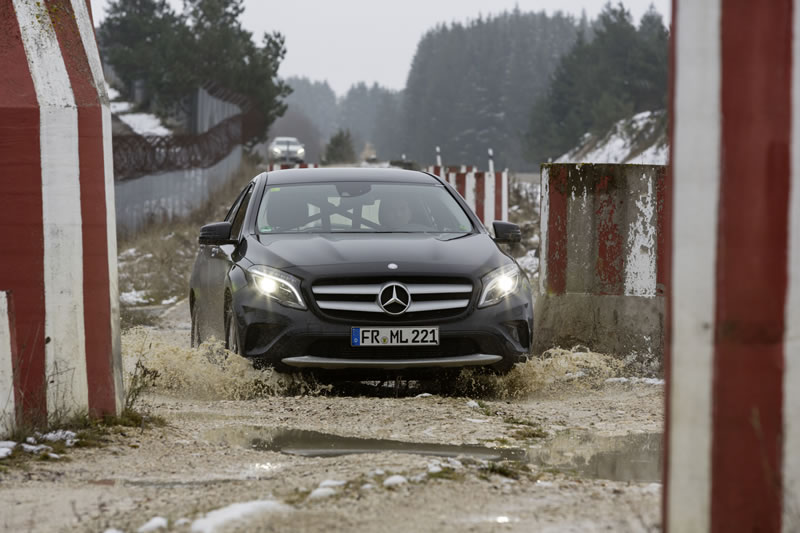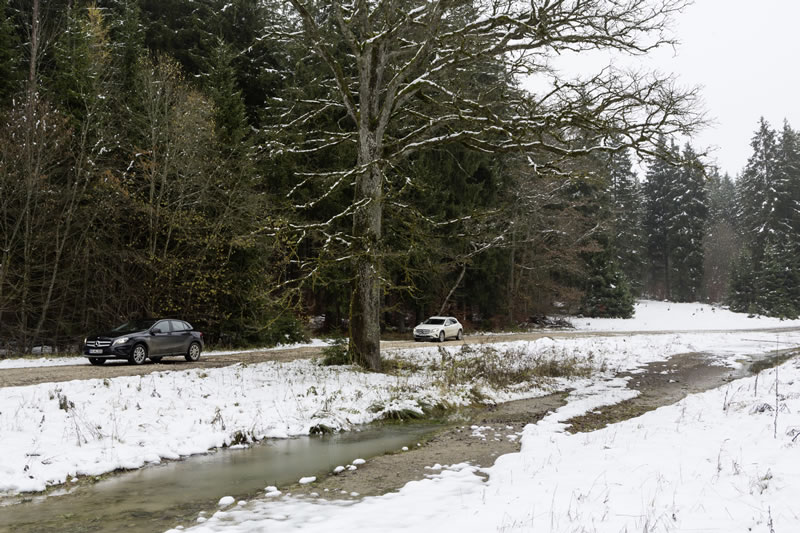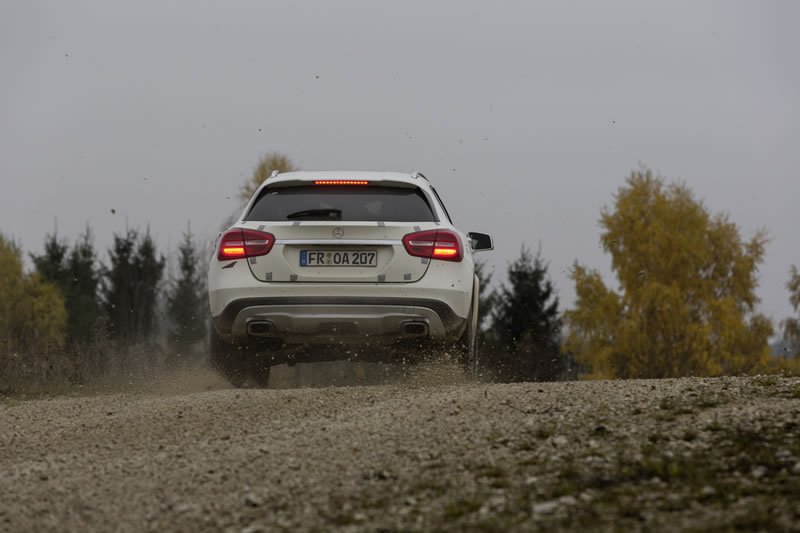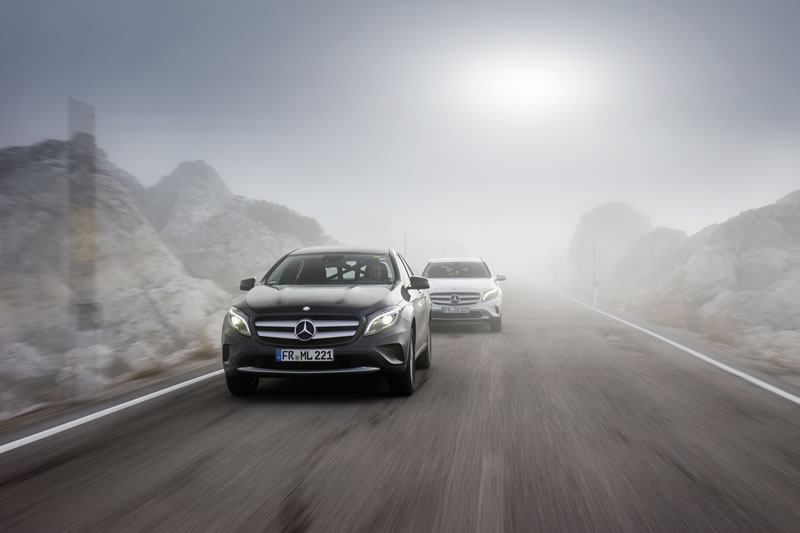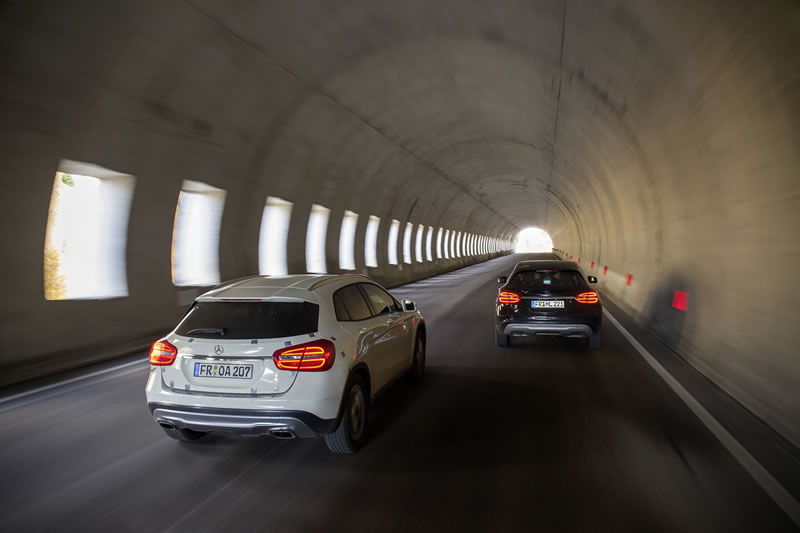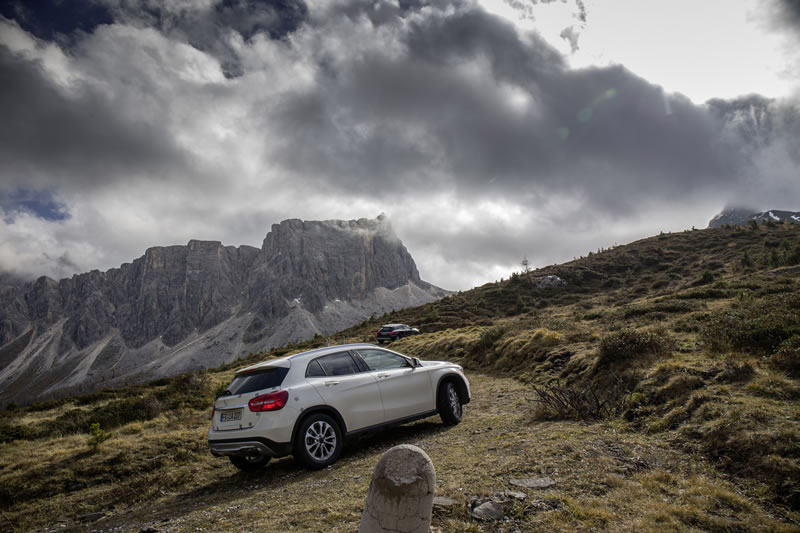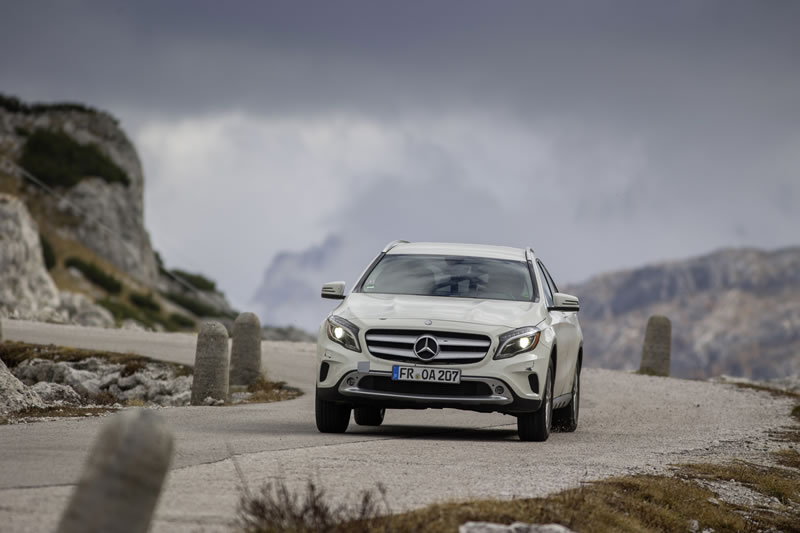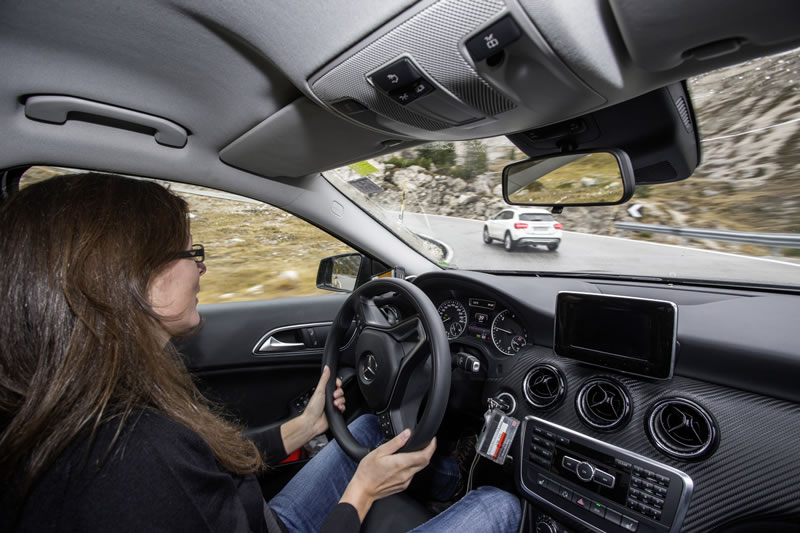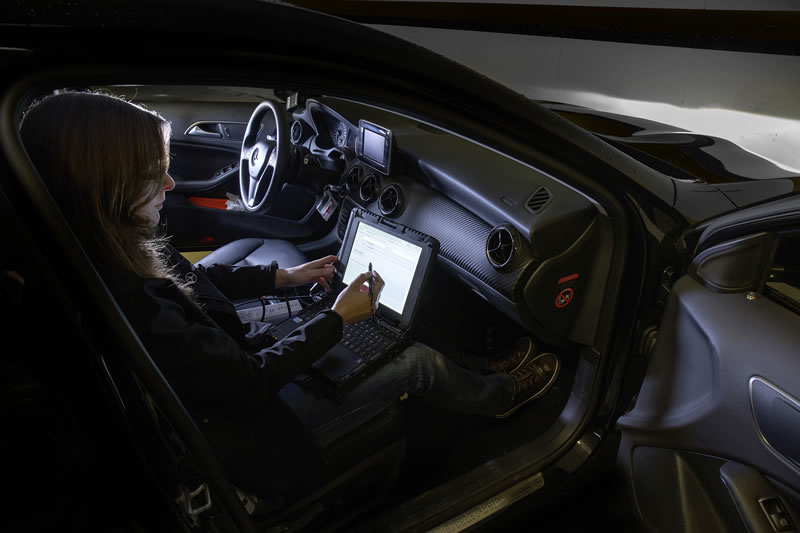The new GLA-Class has successfully completed an endurance trial which, in addition to on-road testing, additionally takes in the stresses and strains typical of off-road all-wheel-drive use. In the course of this track & field endurance trial extending over some nine months, a vehicle’s entire subsequent lifespan in the customer’s hands is simulated at time-lapse speed to verify the GLA’s fitness for series production. In all, 24 GLA models completed this marathon and other endurance tests, racking up a total of over 1.1 million miles in the process.
The focus of the tests in this nine-month GLA marathon was on durability and the reliable operation of the new 4MATIC all-wheel drivetrain, the suspension and the electrical equipment such as the comfort, control and assistance systems. In addition, the track & field test ensures the strength and durability of the entire structure of the SUV bodyshell.

Mercedes-Benz GLA Off-Road Testing
Collection of comprehensive data provides detailed insights
Simulating the entire lifespan of a vehicle within nine months requires a defined load scenario which the test engineers realise with different “load collectives”. The track & field endurance test includes extensive drives on country roads, motorways or in inner-city stop-and-go traffic – disciplines familiar from the conventional road endurance testing programme covering 150,000 kilometres. In part, these stretches are covered by the GLA test vehicles towing a trailer with the maximum allowable towing capacity; this is intended to further intensify the structural loads on the body. But the distance of 1.8 million kilometres covered by the 24 GLA long-distance runners only partially reflects the scope of the test disciplines. In the track & field endurance test the test drivers also check all the controls and operating devices according to an exactly defined procedure.
Always on board with the test driver: the computer to record all the data. It continuously records 190 different measured variables for the standard-fit monitoring and control systems and some 50 variables for additionally installed sensors. In the course of testing, at the end of their shifts the test drivers either link up to specific Daimler in-house access points which transfer the data fully automatically to the Mercedes-Benz Technology Center (MTC) for safe storage and evaluation or, when no access points are available, they save the data on a mobile storage medium for evaluation at a later juncture. So-called pen tops are also used. These serve to provide the test drivers with precise details of the specified test programme. All the events occurring on the test drives are also documented in this system. In particular, subjective impressions of the experienced drivers help to further enhance production maturity.
All information is managed with Daimler’s own development tool FINAS (Vehicle Information and Administration System). Here the complete vita of the GLA prototypes with all measured data and vehicle-specific information such as stage of development, equipment, chassis, tyres or engine are saved, and pending or performed service or repair work is entered.
In each GLA endurance trial the test engineers obtain around 1.8 gigabytes of measurement data, which they evaluate in detail in the course of the track & field endurance trial. This enables them to assess the state of the vehicle and to identify any signs of faults in good time. When faults are identified, a standardised task force procedure involving all the relevant departments comes into effect, ensuring precise diagnosis and reliable remedial action.
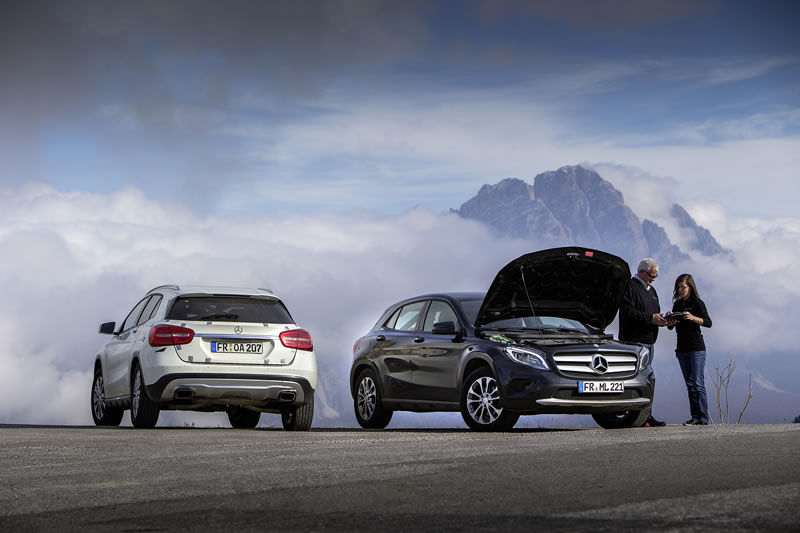
Mercedes-Benz GLA Mountain Testing
Aggravated conditions: Nürburgring, Alps, tank practice grounds
The notorious endurance runs on the world’s toughest race track – the Nürburgring Nordschleife – are well known. A one-kilometre sprint is equivalent to 20 kilometres in the real life of an automobile. And the GLA has to complete 240 laps or around 6000 kilometres here. This means the time spent at the Nürburgring adds up to the equivalent of 100,000 “real” kilometres. As these hot laps involve an element of danger, the endurance test vehicles are equipped with a roll-over cage. The endurance tests in an Alpine environment are similarly demanding. One stretch in the Italian Alps is a veritable helter-skelter ride, with one stage of the test along a distance of 154 kilometres taking in 9 Alpine passes and 450 bends. A difference in elevation of 4300 metres also has to be overcome, and the overall test distance on this track after 20 laps totals 3080 kilometres. The numerous winding bends impose a particular strain on both the chassis and the 4MATIC drivetrain as the vehicle accelerates out of the bends, and ensure that the dynamic handling control systems have their work cut out.
In view of its lineage, Mercedes-Benz requires the new compact SUV to prove its mettle off the beaten track too. After all, in deference to the G-Class – the grandfather of all SUVs and cross-country vehicles with the star – only those vehicles that also meet certain minimum requirements off-road may carry a “G” in their name. To ensure this, the track & field endurance test includes a run that very freely construes the term “primitive road” – the so-called tank ring road of a military training area of the German Armed Forces in southern Germany. Where giant chain-driven 62-tonne vehicles rated at 1103 kW (1500 hp) are normally to be found making their way to the various training areas, churning up the unpaved ground below them as they go, the GLA is required to demonstrate over 1000 kilometres that it is able to stand up to such adverse conditions on a sustained basis.
The sequence of tests plays an important role in the track & field endurance test, as it would make no sense to work successively through each test discipline in isolation. Rather, the track & field endurance test is aligned with the real-life demands placed on an SUV in the customer’s hands. The individual on and off-road disciplines are broken down into test cycles which are completed in varied patterns according to a defined distribution scheme. For instance, a drive over country roads may be followed by an off-road excursion, or a city drive may be followed by a long stretch of motorway, just like in real life.
To cover various load scenarios for a customer-owned vehicle, in addition a number of disciplines involve different loads. For this purpose, either steel bars are firmly screwed to the vehicle floor in the rear, or the test drivers are accompanied by “water boys”: water-filled plastic torsos weighing 82 kilograms, strapped to the seats with standard seat belts.
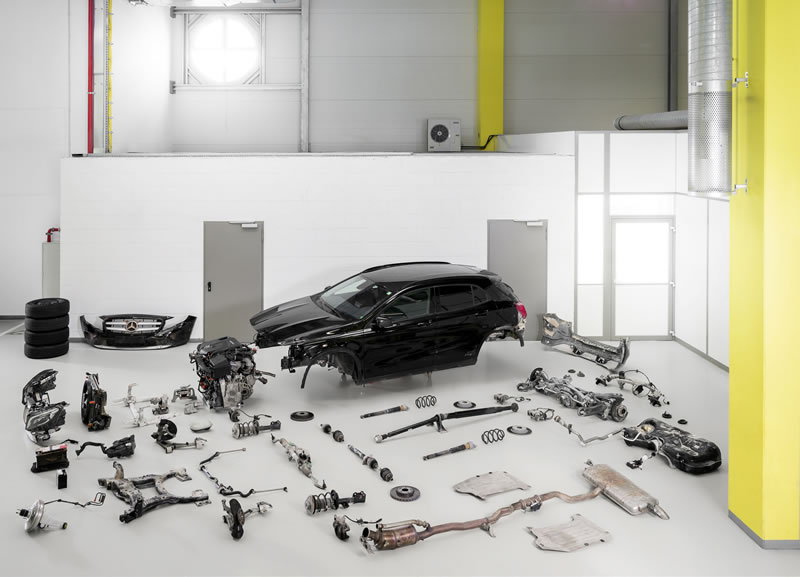
Mercedes-Benz GLA Testing
Grand finale with complete dismantling and detailed assessment
Before the various professional journals worldwide set about examining the solidity and reliability of the SUVs from Mercedes-Benz in endurance tests which generally cover over 100,000 kilometres, the test engineers have already performed this task a couple of dozen times – including complete dismantling. After completing track & field endurance testing, the GLA models are disassembled and their individual components are spread out like an automotive puzzle. Behind closed doors the development and test engineers of the specialist departments subsequently evaluate all vehicle components, focussing on those areas where any anomalies have been observed during the endurance tests and addressed by the above-mentioned task force. If no further nonconformances are found in these sections, their fitness for series production can be certified. However, if further problems, or previously undiscovered problems arise, the task force will go into action again until they find a perfect solution. If in doubt, GLA endurance test subjects are sent on their rounds again and the tests on devices such as the body testing facility or the road simulation test rig are intensified. After the closed-door meetings over the disassembled GLA, further assessments follow: in the appropriate development units the engine, transmission and 4MATIC drivetrain are then completely disassembled, measured and scrutinised.
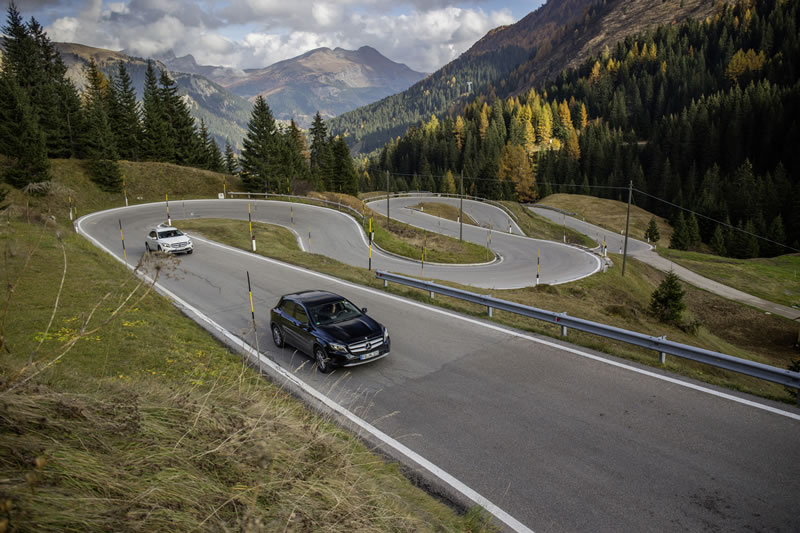
Mercedes-Benz GLA Endurance Testing
Track & field endurance test: one of many
The track & field endurance test rounds off the extensive endurance testing programme carried out worldwide by Mercedes-Benz. This endurance testing programme differs fundamentally from the development and tuning runs performed on new models; these are done additionally. Whereas on these runs the characteristics laid down in the specifications book are verified, programmes like the track & field endurance test verify the reliability and durability of new models.
During the trials such as the road endurance test over 150,000 kilometres or the track & field endurance test over 80,000 kilometres, in which the focus is on the vehicle as a whole, the development engineers also carry out additional, specialised endurance tests:
- World endurance test: 50,000 km worldwide in extreme climatic and topographic conditions
- Trailer endurance test: 25,000 km with a special loaded trailer
- Rough road endurance test: 2000 km over extremely rough roads (“Heide” endurance test)
- Corrosion endurance test: 12-week testing in climate and corrosion chambers and on real-life routes
- Function tests: Checking of control systems and dynamic handling control systems on load-specific routes
- Hockenheim endurance test: 6000 km on the Grand Prix circuit at racing speed
- Full-load endurance tests over 30,000 or 50,000 km on cordoned-off high-speed tracks such as Nardo (southern Italy) or the Mercedes-Benz testing grounds in Papenburg, northern Germany
- Worldwide deployment: endurance testing in Europe, Asia and America verify fitness for series production.
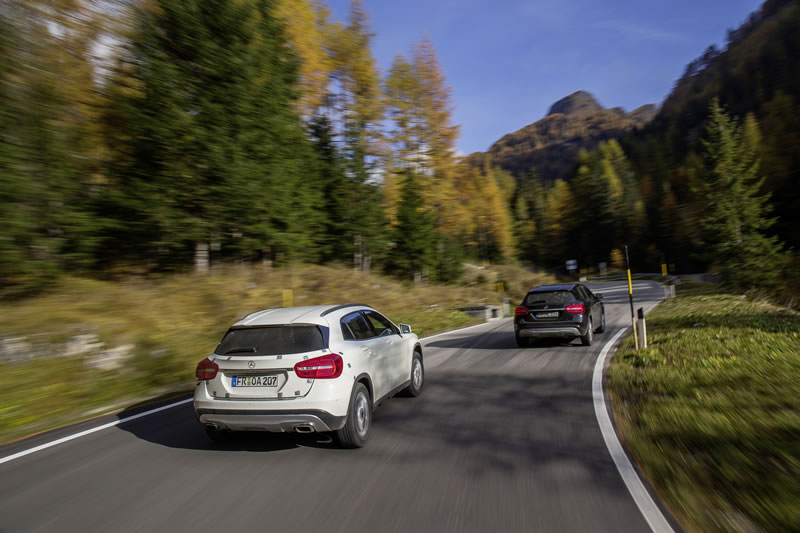
GLA-Class Endurance Test
Sound basis for maximum stability
Nürburgring Nordschleife, Karussell section: The GLA prototype with 67,245 km on the clock drops at a speed of 120 km/h from the left into the high-bank curve which is interspersed with lateral joints, jolting chassis and driver to the limit. Despite the high levels of stress and strain, the compact SUV darts relatively unspectacularly through the 180-degree turn. “No jittering bodywork, high torsional or bending strength, no creaking noises – even after almost 5000 kilometres on the Nordschleife, the GLA body continues to impress me”, the experienced track & field test driver later wrote in his daily report.
Stetten military training site, Panzerringstrasse: On the rain-drenched unsurfaced road dotted with deep ruts, potholes, twists and turns, two GLA prototypes do their rounds at speed, throwing up plenty of mud and stones in the process. The track & field candidate from the Nürburgring endurance test is also in on the action here. With 73,290 km on the clock, it is nearing the end of its testing. The tormented body nevertheless bears up admirably, as confirmed by both the driver’s assessment and the recorded measurements. “The GLA’s body copes particularly effortlessly with winding stretches”, both test drivers confirm.
Just two test days, which serve to demonstrate the high levels of stress and strain to which the GLA’s body was subjected in the track & field endurance test. After completing the tortuous 80,000 kilometres of testing, the merits of the GLA’s chassis and body are established beyond doubt and confirm that this solid basis is built to last a vehicle’s lifetime in operation by the customer, even in the toughest service conditions. The GLA has an extremely rigid body, providing the basis for stable and safe handling characteristics both on and off the road, as well as best-in-class NVH comfort and outstanding passive safety. Weighing in at 400.3 kilograms, 73 percent of the bodyshell is comprised of high-strength and ultra-high-strength steels. In the area of the side roof frame and the new C-ring structure in the rear, hot-formed steels are used – ensuring the highest strength category possible for body steels.
It was decided at the beginning of the development phase that the new GLA was to have a number of features which would raise the vehicle to a class-leading position in terms of comfort, sense of spaciousness and practical attributes. Two aspects posed special challenges for the engineers with regard to the body: neither the very large roof opening nor the wide tailgate opening were to have any negative effect on stability and rigidity.
The GLA offers by far the largest glass roof in its class, with glass covering 64 percent of the roof surface area. As such, this feature guarantees a generous, light and airy feeling of spaciousness, thus enhancing comfort in both the front and rear.
As a result of this feature, the roof bows which are otherwise customary in this area had to be replaced by an appropriate construction in order to keep the torsional stiffness of the body at the same level as with a closed steel roof. This was achieved with a double-skinned roof frame to support the B-pillars, an enlargement of the cross-section at the D-ring, the mentioned heat-formed steels offering the highest possible strength and the use of an extremely sturdy glass sunroof frame firmly bolted to and bonded with the body structure.
The wide tailgate opening, which facilitates easy loading even with bulky objects, required a substantially more complex solution. The engineers at the Mercedes-Benz Technology Center (MTC) developed totally new body structures here. In addition to the D-ring familiar from other models, which forms the rear end of the body, a C-ring is also employed. These two closed ring structures form an extremely stable unit and ensure excellent torsional stiffness. In addition, the two rear shock-absorber strut fixtures are supported by the C-ring. This decisively improves the resistance to forces transmitted from the rear axle connection and thus the NVH (noise, vibration, harshness) characteristics in general.
At the same time, the developers compensated the loads in the rear area of the body by means of the new spindle-type actuator of the optionally available automatic tailgate. Very high forces arise here particularly at the beginning of the automatic opening process. These are reliably absorbed by the highly robust combination of C and D-ring.
The outstanding stability of the GLA’s body-in-white will also be highlighted by the Mercedes-Benz GLA 45 AMG which is to be launched in due course. This high-power SUV with a 2.0-litre turbo engine offers an output of 265 kW (360 hp), maximum torque of 450 Newton metres and does not require any reinforcement of its body, despite its vast power.
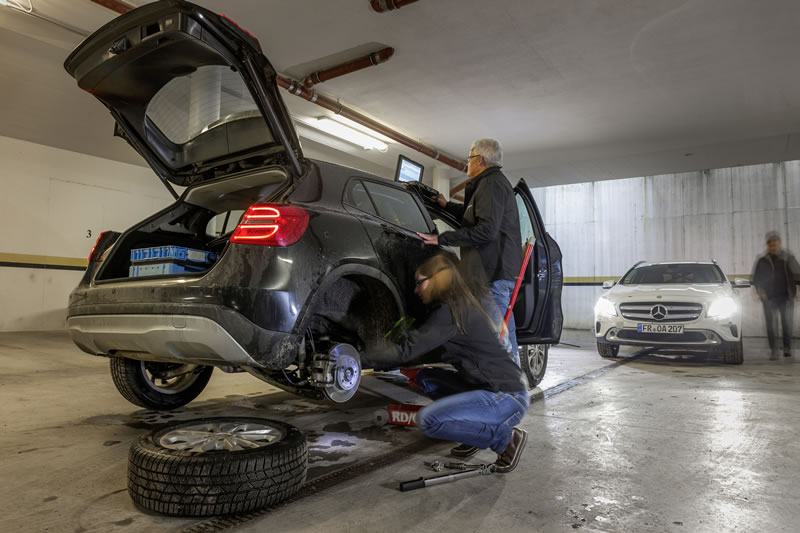
GLA-Class Endurance Test
All set for any operating conditions: 4MATIC and 7G-DCT
The new 4MATIC from Mercedes-Benz is featuring for the first time in an SUV. This permanent all-wheel drive with fully variable torque distribution is tailor-made for the compact SUV GLA, as the off-road variant of the new 4MATIC all-wheel drive based on the front-wheel-drive architecture formed an integral part of the system development process. The engineers accorded due consideration to deployment in off-road vehicles right from the earliest phases of development. On the GLA 4MATIC models and with larger wheels, higher wheel torques apply in particular in off-road use, for example. The drive shafts require to be specially adapted to the optional raised off-road comfort suspension and the resultant articulation angle in the compensating joints. Both on and off-road, the new 4MATIC harmonises outstandingly with the 7G-DCT automated dual clutch transmission.
Looking smart off the beaten track with off-road control features
Vehicles with 4MATIC feature additional off-road control functions and Downhill Speed Regulation (DSR) as standard. DSR is activated via a control button in the centre console to assist the driver on steep and demanding downhill stretches. The vehicle speed which was previously set using the cruise control lever on the steering column and is shown on the central display is maintained automatically, as far as the physical limits allow. This is done with the help of the engine and transmission control systems, and by targeted brake intervention. Conversely, the start-off assist system and the HOLD function assist the driver when starting off uphill.
As a result of the off-road functions, the transmission shift points, accelerator pedal characteristics and thresholds of the dynamic handling control systems are adapted accordingly, resulting in substantially enhanced off-road capabilities. Another useful off-road option is the off-road comfort suspension (front +30 millimetres, rear +22 millimetres). This raising of the suspension yields several advantages. The resultant increase in spring travel provides the GLA’s wheels with longer ground contact and subsequent improved traction on heavily contoured terrain. Comfort is also enhanced, and the raised seat position provides better all-round visibility, both off and on-road.
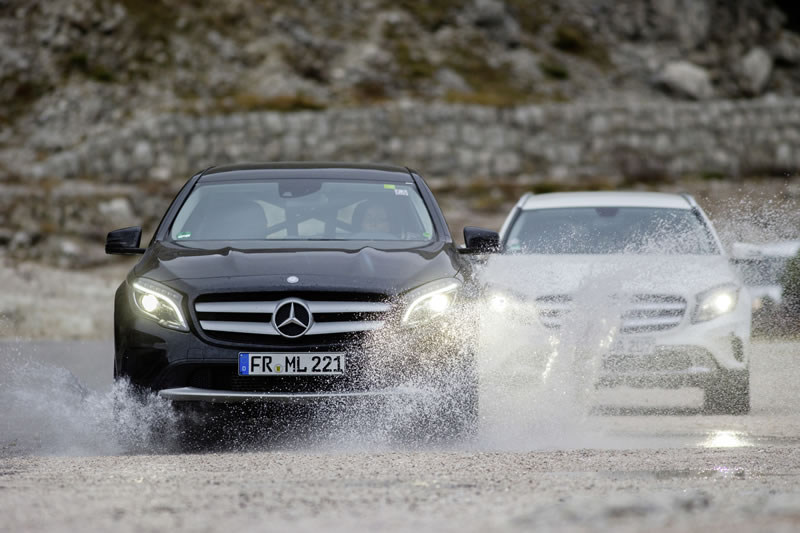
GLA-Class Endurance Test
All-round view: off-road display and off-road lights
In combination with the Audio 20 CD (standard) and COMAND Online (optional extra), an on and off-road display can also be activated on the CENTRAL MEDIA DISPLAY. The steering angle and a compass are shown in this mode. The roll angle in degrees, the gradient in percent and activation of Downhill Speed Regulation DSR are also indicated. All 4MATIC models equipped with the Intelligent Light System (ILS) also feature off-road lights, which provide for improved visibility during night-time off-road driving. When travelling at low speeds in confusing off-road terrain, the broadest and brightest possible illumination of the area in front of the vehicle is expedient to enable more effective and faster recognition of obstacles. The off-road lights go on automatically when the driver activates the off-road drive programme while the headlamps are on. To this end, the bi-xenon headlamp modules pan outwards by 6 degrees, the luminous power of the xenon burner is increased by 3 W and a symmetrical light distribution is set. In addition, the LED cornering lights on both sides are switched to permanently lit mode, while dynamic curve illumination and range adjustment are deactivated. These settings ensure broader and brighter illumination of the area directly in front of the vehicle compared with ILS, which is optimised for on-road use. This helps the driver to find their way in off-road terrain substantially more effectively and enables any obstacles to be recognised more quickly. Off-road lights are active up to a speed of 50 km/h. Once the driver exceeds this threshold, ILS automatically switches back to the light functions optimised for road use.
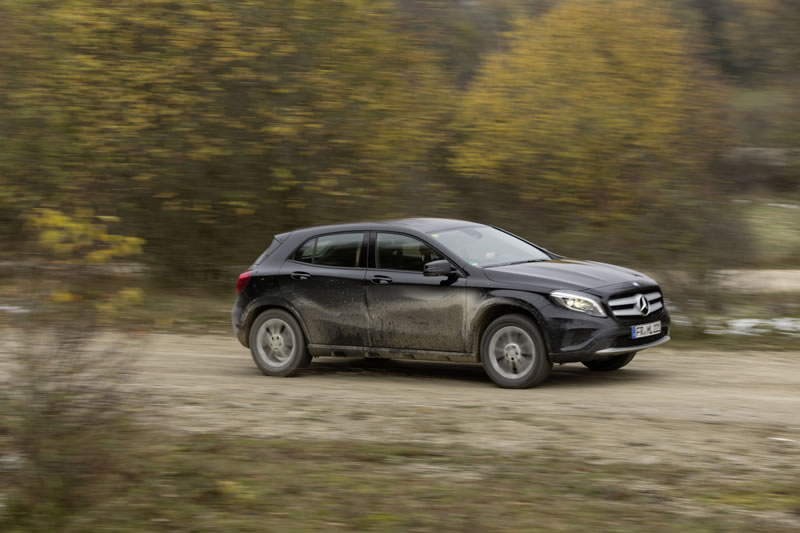
GLA-Class Endurance Test
The “Heide” test – the mother of all car endurance trials
Anyone motoring around the Lüneburg Heath at the beginning of the 1950s needed to be brave, unflinching and able to shrug off the knocks that beckoned along the way. The routes around Hollenstedt and Moisburg had very little to do with what we generally understand by the term “road”. Asphalted surfaces were extremely rare and for the most part traffic had to make do with unsurfaced roads abounding in potholes and bumps or rough cobblestones that took their toll on body, suspension and occupants alike. Reports on the state of the roads here also filtered through to Stuttgart, where the development engineers at Mercedes-Benz were always on the look-out for suitable stretches on which to test new models. Following an extensive scouting expedition to the north of the young republic, the “Heide test” became a firmly established element of the Mercedes test programme. After completing a few drives at the “Heide”, it was clear that they had chanced upon an ideal testing area. The terrain proved such a trial for body, chassis and suspension that a degree of stress and strain corresponding to a car’s entire lifespan became apparent in the space of a few weeks.
So as to avoid the successive modernisation of the Lüneburg Heide infrastructure putting an end to the test drives, the stretches were duly duplicated, giving rise to authentic copies first of all at the Mercedes test site in Untertürkheim in the mid-1960s and later also at other test locations such as Sindelfingen or Papenburg. This was no simple matter, as a report from 1967 on the extended test site in Untertürkheim reveals:
“….In transferring particularly difficult stretches to the new site, the original profile was sampled with geodetic precision using iron wheels in two lanes and then plotted on graph paper. A wooden template was then produced, from which the concrete mix was removed in a final step. In this way, a test site with an endlessly diverse range of different stretches was painstakingly created. Half of the test sections totalling 15,460 m in length were provided with decidedly awful surfaces….”
The “Heide” test thus laid the foundation of today’s extensive endurance trials in which around 350 prototypes each year are required to demonstrate their resistance to extreme stress and strain. Close synchronisation between the real-life on and off-road endurance tests throughout the world and the numerous tests carried out on test rigs such as the body testing rig guarantees even more meaningful results. While roads such as those in the Lüneburg Heide around 1950 are very rarely to be found in central Europe today, the GLA is an SUV with off-road capabilities. This means that it is still required to stand up to test runs in conditions corresponding to those in the Lüneburg Heide shortly after the Second World War. In keeping with Mercedes-Benz’s philosophy on SUVs, even though only a small number of customers actually venture off road, cars with off-road capability such as the GLA are among the most robust and high-performance models within their market segment.
